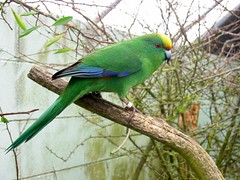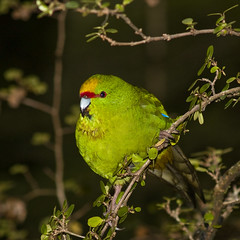Thursday, October 14, 2010
Ka Pai Kakariki
New Zealand has spoken, the kākāriki is our newest Bird of the Year. It took a late surge to push the slender parrot past the other main contender for the prize, the pukeko, but in the end the kākāriki won a clear majority and it's time for the nation to celebrate these endangered birds.

New Zealanders are rightly proud about some of the weirder creatures that call our islands home. Our native wrens, frogs, tuatara, large parrots and kiwi are all examples of ancient lineages found in New Zealand and nowhere else in the world. These species, and our geological origins, have formed part of New Zealand's creation myth - a country that went its own way 85 million years ago and has been doing its own thing ever since. The kākāriki don't fit in that narrative. Instead, theses parrots connect New Zealand's biota to the Pacfic and serve to highlight the way the recent geological and climatic history of our islands has shaped the creatures we share them with.
When we say kākāriki we are actually talking about three species of small parrot, each native to New Zealand. There had been considerable debate among ornithologists about whether the different forms, which are most easily differentiated by the colour of a patch of feathers on their forehead, really represent different species rather than variants of a single species. In 2001 Wee Ming Boon, then a PhD student at Victoria University in Wellington provided the answer. Molecular data showed that each of these forms are distinct from each other.
When Europeans first arrived in New Zealand all the kākāriki species were relatively common in beech forests. So much so that when the beech failed to set enough seed for the parrot populations they would invade the settler's farms and orchids. Robert Fulton, speaking to the members of the Otago Insitute in 1907, noted how the birds which had been "shot in their thousands" only thirty years before had all but disappeared. (The Otago Witness also recorded Dr Fulton's sentiment that the way Kererū were slaughtered in the province put Otago-ites on "the same level as the Spanish and the Mexicans") . Today all three species are endangered, deforestation and the introduction of mammalian predators like the stoat being a much more to blame than early orchardists. The yellow fronted species is still relatively widespread, whereas the red fronted is extinct on the mainland and the orange fronted is restricted to few small pockets of beech forest in the South Island and there may be as few as 50 birds left.
All three species are in the genus Cyanoramphus, which has representatives stretching from Raiatea in the Society Islands all the way down to Macquarie Island in the sub-antarctic. The same sort of molecular evidence that was sued to establish species status for the various kākāriki can be used to establish relationships between them and their Pacific cousins. The New Zealand species are most closely related to a species from New Caledonia. Using a molecular clock analysis, Boon and colleagues could show that modern populations of kākāriki on New Zealand and the Chatham Islands descend from a single invasion of our country from the Pacific, most likely from New Caledonia, within the last five hundred thousand years. Interestingly, the three New Zealand species split even more recently than that. It seems seems populations of kakariki become isolated within pockets of beech forests that survived the last ice age. Seperated in this way, populations would become become independently evolving lineages, which in turn can come species.
It might seem that recent arrivals like the kākāriki aren't quite as uniquely New Zealand a group of birds as those ancient and odd birds like the kakapo and the kiwi. But, as we've been able to apply molecular tools to more and more of the plants and animals we share our islands with it's become increasing clear that recent arrivals far out number the old timers. In fact, in many ways the kākāriki is a perfect example of the way life has evolved in New Zealand . It's been here for only a short while, but in that time the turbulent geological and climatic history has shaped these birds in a unique way. So, apart from being very handsome parrots indeed, the kākāriki are worthy holders of the title of Bird of the Year. Now let's just make sure we get to keep some of these birds in our forests!
Labels: bird of the year, evolution, kakriki, new zealand, sci-blogs






